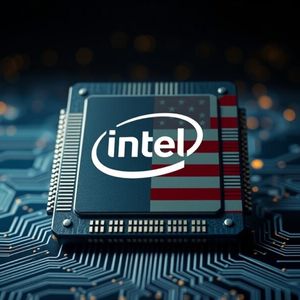BitcoinWorld Intel Foundry’s Uncertain Future: Why US Government Intervention May Not Be Its Savior In the rapidly evolving world of technology and digital finance, where every microchip powers everything from our smartphones to complex blockchain networks, the health of major chipmaker s like Intel is of paramount concern. Recently, the tech giant found itself at the center of a perplexing and controversial move by the Trump administration, which announced plans to convert funds originally earmarked for Intel through Joe Biden-era government grant programs into a 10% equity stake. This unprecedented decision has sparked widespread debate across the industry, raising critical questions about its legality, its efficacy, and its ultimate impact on Intel Foundry ‘s struggling business. For those invested in the digital economy, understanding the implications of such a significant US government intervention is crucial, as it could ripple through the entire supply chain, affecting everything from hardware availability for crypto mining to the foundational infrastructure of AI. The Deep-Rooted Challenges of Intel Foundry Intel, a name synonymous with innovation in computing for decades, has been grappling with significant headwinds in its foundry business. The ambition to become a major contract manufacturer for outside customers – a strategic pivot known as Intel Foundry – has proven to be a challenging endeavor. Unlike its historical model of designing and manufacturing chips primarily for its own products, operating a foundry demands a different ethos, one centered on rigorous customer service, competitive pricing, and cutting-edge process technology. Unfortunately, Intel’s journey in this space has been anything but smooth. Financial Setbacks: The financial performance of Intel Foundry has been a stark indicator of its struggles. The business division reported a staggering operating income loss of $3.1 billion in the second quarter alone. These losses underscore the substantial investment required and the difficulty in securing lucrative contracts against established players like TSMC and Samsung. Lost Opportunities: The company has reportedly missed out on significant potential contracts, including a notable one with Sony, as highlighted by Reuters. Such missed opportunities are not just financial blows but also signal a lack of competitive edge in attracting and retaining major clients. Workforce Impact: The operational difficulties have had a human cost, with thousands of layoffs since the beginning of the year. The foundry business unit, unfortunately, bore a significant brunt of these workforce reductions, indicating a painful restructuring process. Leadership Departures: Even leadership has felt the strain. Differences over the strategy to revitalize the struggling foundry business were partly responsible for Lip-Bu Tan’s resignation from the company board in August 2024, despite being appointed CEO in spring 2025. This internal discord highlights the deep-seated challenges and the difficulty in charting a clear path forward. Kevin Cassidy, a managing director at Rosenblatt Securities, articulated a key issue to Bitcoin World: “They didn’t understand customer service. They have always manufactured internally, the manufacturing group was king. It’s hard to be a customer service-focused group when you think you know better.” This insight points to a fundamental cultural hurdle within Intel, where a historical focus on internal innovation may have inadvertently hampered its ability to serve external clients effectively. Understanding the US Government’s Controversial Tech Investment The Trump administration’s move to convert promised government grants into a 10% equity stake in Intel is a complex and highly debated topic. These grants were initially part of broader Biden-era initiatives, likely stemming from the CHIPS and Science Act, designed to bolster domestic semiconductor manufacturing . The act aims to reduce the U.S.’s reliance on foreign chip production, a critical national security and economic imperative, especially given global supply chain vulnerabilities and geopolitical tensions. The shift from direct grants to an equity stake is significant for several reasons: Unprecedented Nature: This type of direct equity acquisition by the U.S. government in a major public company is rare, particularly in the tech sector. It signals a more hands-on approach to industrial policy than typically seen. Legal Ambiguity: As the original article notes, it remains unclear if converting government grants into equity is even legally or practically feasible. Such a conversion would likely involve complex negotiations, regulatory approvals, and potentially legislative changes. Strategic Intent: While the administration claims it aims to support Intel’s resurgence and domestic chip production, the method raises questions about the long-term implications of government ownership in private enterprise. Is it a bailout, a strategic partnership, or a precursor to further intervention? The motivation behind this move is ostensibly to secure a stake in a vital industry for national interests, particularly in the context of advanced technologies like AI and high-performance computing, which are heavily reliant on cutting-edge semiconductors. However, the chosen mechanism of equity rather than non-dilutive grants introduces a new layer of complexity and potential conflict. The Ripple Effect: Investor and International Concerns for the Chipmaker While the government’s intention might be to bolster a struggling American chipmaker , the deal has immediate and palpable downsides, particularly for Intel’s existing stakeholders and its global business operations. Intel itself acknowledged these risks in a recent SEC filing, highlighting potential impacts on investors and customers – two groups crucial for any company’s sustained success. How Does This Impact Existing Shareholders? The most direct consequence of the government acquiring a 10% equity stake is the dilution of existing shareholders. When new shares are issued or converted, the ownership percentage of current shareholders decreases, and their governance rights are proportionally reduced. Kevin Cassidy voiced this sentiment clearly: “I would be disappointed if I was a stockholder. Intel gave up another 430 million shares, and diluted my shares, and [they] were able to buy it at a 20% discount.” This perceived discount further exacerbates shareholder dissatisfaction, as it implies the government acquired its stake at a favorable price, potentially at the expense of existing investors. While the Trump administration stated it would vote alongside Intel’s interests, this promise may not fully assuage concerns about reduced influence and financial value. Navigating International Business Amidst Government Ownership Another significant challenge lies in the potential impact on Intel’s international business. The company’s global footprint is immense, with a vast majority of its revenue – 76% in its last fiscal year – generated from outside the U.S. In an era marked by increasing U.S.-led international trade tensions and geopolitical rivalries, particularly with China, a direct equity stake by the U.S. government introduces a new layer of complexity. International customers and partners, especially those in countries with strained relations with the U.S., might now have to reconsider the implications of working with a company partially owned by the American government. This could lead to a loss of business or increased scrutiny, potentially undermining Intel’s global competitiveness. A Glimmer of Hope? Evaluating the Strategic Tech Investment Despite the considerable concerns, not everyone views the government’s intervention with complete pessimism. Some analysts see potential upsides, viewing the government’s commitment as a strategic tech investment that could provide a much-needed lifeline, even if it’s not a complete solution. Is Government Backing a Stepping Stone for Semiconductor Manufacturing? Cody Acree, managing director and senior research analyst at Benchmark Company, offers a more optimistic perspective. He told Bitcoin World that he doesn’t anticipate Intel’s international customers shying away significantly. Acree views the deal, while imperfect, as a potential catalyst: “Intel has shown that it’s been struggling for the last decade and may need some kind of government intervention, a bail out is probably too harsh of a term, but the government intervention is being seen as at least a stepping stone toward reinvigorating Intel. I don’t necessarily agree with it being a fix-all by any means. It’s at least encouraging to know that the government is backing Intel instead of challenging the leadership as they were a month ago.” This perspective suggests that the psychological boost of government support, signaling a national commitment to Intel’s success, could be valuable in itself, offering stability and confidence to stakeholders. The Domestic AI Push and Intel’s Role Andrew Rocco, a stock strategist at Zacks Investment Research, further emphasized the potential positives, particularly in the context of the U.S. administration’s broader push for domestic AI prowess. Initiatives like OpenAI, SoftBank, and Oracle’s Stargate highlight the critical need for advanced semiconductor manufacturing capabilities within the U.S. Rocco believes that a deal with the U.S. government could position Intel for a more prominent role in this national strategy. “The market is going to be so big, the datacenter and chip market, even if they get a small slice, there is room for them to succeed. This will be a positive. You have to have a five-to-10-year time horizon.” This long-term view suggests that while immediate returns might be uncertain, Intel’s alignment with national strategic goals could unlock significant opportunities in the burgeoning AI and data center markets, where demand for high-performance chips is exploding. The Path Forward: Beyond Government Intervention for the Chipmaker While the government’s equity stake might offer a temporary reprieve or a strategic alignment, both Acree and Cassidy agree that this deal alone won’t be Intel’s savior. For a true, long-standing rescue, Intel needs to look inward and fundamentally transform its approach to its foundry business. Internal Transformation: The Real Test for Intel Foundry The core issue, as highlighted by Cassidy, remains Intel Foundry’s customer service model. Shifting from an internal-focused manufacturing culture to one that prioritizes external customer needs, flexibility, and responsiveness is paramount. This involves not just technical excellence but also a deep understanding of market demands, competitive pricing, and building strong client relationships. Without this internal transformation, even substantial financial backing or strategic government alignment will only provide temporary relief. There’s also the potential for indirect government influence. Acree noted that while the Trump administration claims it will be a passive investor, its involvement could subtly “drum up business for the company.” Cassidy added that this could happen even without direct pressure, as corporate America has often shown a willingness to align with administration goals. The prevalence of “pro-America” sentiment since the Trump administration took office could lead American companies to favor Intel’s chips and hardware, potentially providing a boost. However, this form of influence, while beneficial in the short term, doesn’t address the underlying operational and competitive challenges Intel faces in the open market. The 14A Chipmaking Process: A Critical Benchmark for Semiconductor Manufacturing The real litmus test for Intel’s resurgence, according to both analysts, won’t be the government deal itself, but whether Intel can generate substantial customer interest for its advanced 14A chipmaking process. Lip-Bu Tan had previously stated that the company would not commence production on its 14A process until significant customer commitments were secured. This underscores the need for Intel to prove its technological competitiveness and its ability to attract and retain leading-edge clients. Cassidy summarized the precarious situation: “There is still no guarantee that Intel is going to be able to come back into the market at the leading edge. Intel has been burning cash for quite a few years, I don’t know if it is just more money to buy time to find the formula to get them back on the leading edge.” This sentiment captures the critical juncture Intel is at: the government’s tech investment might buy time, but it doesn’t automatically guarantee the innovation, efficiency, and customer focus required to regain its leadership position in the fiercely competitive semiconductor manufacturing landscape. Conclusion: A Complex Road Ahead for Intel The U.S. government’s decision to take an equity stake in Intel represents a dramatic and potentially game-changing intervention in the American tech landscape. While proponents argue it’s a vital step to bolster domestic semiconductor manufacturing and secure national interests in the age of AI, the move comes with significant risks, including shareholder dilution and potential complications for Intel’s extensive international business. The core problem, as experts point out, isn’t a lack of funds but a fundamental need for cultural and operational transformation within Intel Foundry to better serve its customers. This US government tech investment may offer a temporary cushion or a strategic advantage in the domestic market, but the ultimate salvation for this iconic chipmaker will depend on its ability to innovate, adapt, and demonstrate a renewed commitment to customer excellence. The road ahead for Intel is complex, demanding not just external support but a profound internal renaissance to secure its place at the leading edge of the global technology race. To learn more about the latest AI market trends, explore our article on key developments shaping AI features. This post Intel Foundry’s Uncertain Future: Why US Government Intervention May Not Be Its Savior first appeared on BitcoinWorld and is written by Editorial Team














